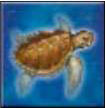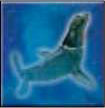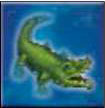

Hippopotamus: this herbivore is related to pigs. It is the second largest land animal and can achieve the amazing speed of approximately 30 mph despite its weight, which can reach 10000 pounds and a length of up to 14 feet.

Dolphin: this pleasant mammal is considered by many the most intelligent animal and is particularly noted for its acrobatic ability and its social behavior. The dolphin can dive up to 1500 feet deep for as long as 15 minutes before returning to the surface to breathe.

Orca: this large whale can be up to 25 feet long and 20000 pounds. They prefer Arctic and Antarctic waters. This remarkably successful hunter is the fastest well-known sea animal capable of speeds up to 90 mph.

Sea Turtle: these armored animals have been paddling around for about 200 million years, mostly in tropical and subtropical seas. They follow the currents and, thus, range across large areas. They leave the water to reproduce by laying eggs in the land areas along their long sea routes.

Penguin: they are found primarily in the cold regions of the Southern Hemisphere and are very well adapted to that life. They are excellent divers, but are not fast swimmers. However, they can maneuver well and at a high rate to evade predators. They can also leap up to 7 feet from the water.

Polar Bear: this loner from the far north has a great sense of smell and is very important in the traditions of the Inuit, who call them "Nanuk". Despite its size and its weight, the polar bear can easily float on the sea for as far as 40 miles.

Sea Lion: these very social animals form large colonies and can be seen basking at numerous rocky islands in the sea. They are not the fastest swimmers, but among the most acrobatic in the water.

Crocodile: these creatures can reach 20 feet in length and are direct descendants of the Archosaur of the Trias. They are per- fectly camouflaged and spend the majority of their lives in the water, often only showing eyes and nostrils above the surface.
Continue Reading

